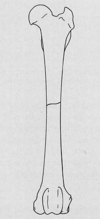Lectures 4-6 (Q1) Flashcards
(107 cards)
What is the radiopharmaceutical used in Scintigraphy?
Technetium
(99mTc)
What are the main clinical applications of Scintigraphy (5)?
- Bone scans → lameness evals
- Thyroid scans
- Parathyroid scans
- Renal scans
- PSS studies
What agent is used for bone scans?
MDP
(Methyline Di-Phosphate)
What does MDP bind to in bones?
hydroxyapatite crystals
What is MDP localization in bone dependent on?
Depends on the rate & extent of bone remodelling and blood perfusion
What is the drawback of scintigraphy?
- Not very specific (but is highly sensitive)
- Lesions can be ID easily but can’t DX w/o using further techniques
List the safety concerns you must take into account when using MDP.
- Protective gear (i.e. gloves, etc)
- Remains in the urine for 48 hrs.
- Need to keep the animals in controlled areas to prevent exposure to non-protected individuals
- Will have contaminated bedding & kennels
List the 3 Imaging Phases of a Bone Scan.
- Phase I: Vascular or pool phase
- Phase II: Soft tissue phase
- Phase III: Bone phase
Characteristics of the Vascular phase of a bone scan?
- Area imaged = vasculature & extravascular fluid
- Very short phase
- Only 1 area can be imaged
- Best real-time
Characteristics of the Soft tissue phase of a bone scan.
- Distributed in the ECF of all body tissues
- Occurs 1- 15 min post injection
Characteristics of the Bone phase of a bone scan.
- IDs pathological increases in blood flow & bone pathology
- Occurs 2-4 hrs. post injection
How is the image formed in Scintigraphy?
- Gamma camera records radiation emitted from P
- Photomultiplier tube inside the camera transforms the light into an electric signal
- Intensity of radiation = pixel brightness
What is proportional to Tc uptake in Scintigraphy?
Tc uptake is proportional to the intensity of radiation
What is a “hot spot” on Scintigraphy?
An area of increased uptake =
increased bone/soft tissue activity
What does 99mTcO4 allows you to visualize?
Thyroid morphology
What does 131I or 123I allow you to visualize?
Thyroid fxn
Which organ should show similar
uptake to the thyroid?
the salivary glands
What is Fxnal Renal Scintigraphy used for?
What is the radiopharmaceutical used?
- GFR calculation
-
99mTc-DTPA
- Diethylene triamine pentaacetic acid
What % of 99mTc-DTPA is boung to plasma proteins?
5-10%
What radiopharmaceutical is used for
Scintigraphy of PSS?
- Sodium 99mTc-pertechnetate → trancolonic/transsplenic scintigraphy
- <strong>99m</strong>Tc-mebrofenin → transsplenic scintigraphy + liver fxn assay
Where will the radiopharmaceutical accumulate in a normal patient in a PSS Scintigraphy?
In the liver
Where does the radiopharmaceutical accumulate in PSS patients?
- Predominately in the cardiac chambers
- Minimal to no uptake in the liver
How is Leukoctye Scintigraphy used in Equines?
to ID foci of inflammation
How are Scintigraphic Ventilation-Perfusion studies utilized?
To evaluate Ventilation/Perfusion matching




























